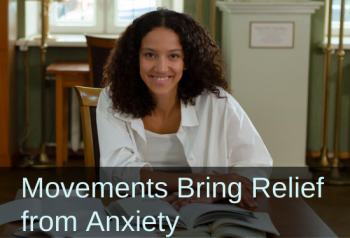25 YO Law Student—Less Panic, Better Focus and Sleep; Increased Strength and Happiness
Submitted by Emily E Nemec, OTD, OTR/L

|
Before
|
After
|
|
Diagnosed with generalized anxiety disorder
|
|
|
Had trouble building strength and stability in her core and upper body
|
Enjoys lifting weights and doing mat exercises much more; "individual muscles felt like they were finally turning on”
|
Georgia is a 25-year-old female law school student with medical diagnoses of generalized anxiety disorder, panic disorder, attention deficit and hyperactivity disorder, and irritable bowel syndrome. She was delivered via Caesarean section 2 weeks prior to her due date due to pregnancy complications. Georgia experienced difficulty with sports and physical activities as a child, and briefly received physical therapy for mild spine curvature and weak core strength at 12 years old. She presents with mild to moderate joint laxity and her overall muscle tone is at low range of normal. Georgia has difficulty with body awareness, evidenced by frequently bumping into furniture or other large objects, losing balance, knocking items over, and difficulty with controlled reach and force gradation. She experiences motion sickness in cars and airplanes. In recent months, she has noticed increased levels of anxiety, hyperactivity, and feelings of panic.
Georgia was assessed for integration of the reflexes taught in the Brain and Sensory Foundations, First Level course. She reported some feelings of imbalance during extension portion of the TLR check, though no signs were observed by therapist.
She presented with positive signs for unintegrated STNR and Spinal Galant reflex. She also had signs and symptoms associated with retained Fear Paralysis, Moro, and Palmar/Babinski reflexes.
I first taught Georgia brain tune-ups and all four rhythmic movements [from the Brain and Sensory Foundations course] to both prime her nervous system and to begin teaching her tools to tackle symptoms of anxiety and ADHD.
Georgia worked on trying these tools at home while checking in with me each week to fine tune rhythmic movement positioning and strategies and discuss ways to integrate these activities into her regular routines. With the support of her partner, Georgia had success increasing her ability to perform rhythmic movements actively while keeping a consistent rhythm. She initially had difficulty implementing the brain tune up. When she felt stressed or upset, she wanted to focus on solving the problem and it was difficult to remember to step away and implement the brain tune up. She and I worked together to add simple visual cues in her home and on her phone and computer to remind her of this strategy. Over the course of the three months that we worked together, Georgia reported improved awareness of escalating anxiety and was able to implement the brain tune up to prevent or reduce adverse effects of anxiety/stress. She reported overall increased calm and focus, especially in the minutes after using the brain tune up.
As Georgia spent more time with the rhythmic movements, she started noticing exciting differences in her body. She was able to fall asleep more easily, and noticed that she was using her panic attack rescue medication much less frequently. Before starting our work together, Georgia tried to exercise a few times each week, but had trouble building strength and stability in her core and upper body. I introduced isometric exercises for TLR, Spinal Galant, and STNR (in that order) over the course of the three months we worked together, and she found that she enjoyed lifting weights and doing mat exercises much more as she worked on integrating these reflexes. In her words, she felt “like [she] could feel in her body which joints [she] needed to stabilize and individual muscles felt like they were finally turning on.”
As I introduced isometric exercises, I also shared the 5-step balance process with Georgia. We discussed positive, present-tense goals, and Georgia shared later with me that she almost always chose goals that were related to feeling strong while exercising or feeling joy and gratitude (in place of worry). Of all the tools I introduced to Georgia, she found the 5-step balance most helpful. The first time we tried it, she said her body felt lighter and she felt noticeably happier and less burdened. She continued to use it almost daily, often with her partner, and reported that her friends and the other students in her law school cohort started to notice that she seemed generally calmer and happier in her day-to-day life.
While working with Georgia I was reminded that implementing home programs can be difficult for some clients. This difficulty was likely exacerbated by Georgia’s ADHD symptoms. She and I were able to work together to develop creative, simple solutions to increase her engagement in home exercises, like visual cues and alarms or reminders on her phone. I learned that it is important to move slowly with patients and introduce new materials and exercises at their own pace. That pace may be determined not only by physical or psychological indications, but also may be impacted on a client’s time management skills, schedule, treatment priorities, and willingness to engage with therapy. Georgia wanted to engage in home exercises, but often forgot to do so or mentally placed them at a lower priority in her busy schedule. When we added in the 5-step balance process, [from the Brain and Sensory Foundations course] she quickly became more consistent in implementing her home exercises within the framework of the 5-step balance. I realized that Georgia’s buy-in was strongly linked to the immediate positive feelings she felt after completing a 5-step balance. Successful therapeutic intervention is always guided by the client’s pace and feelings, It’s so important to build from success to make clients feel motivated and empowered. The 5-step balance was the key that unlocked that for Georgia.
(Edited, emphasis added)


